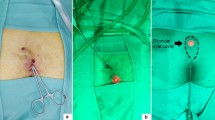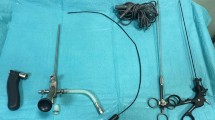Abstract
Background
Pilonidal sinus disease (PD) is a chronic condition involved in natal cleft. Excision surgery carries equally morbid course of recovery to that of disease itself. Minimally invasive treatments therefore have been developed to minimise morbidity and improve healing rates. This review looks at the literature on effectiveness of endoscopic pilonidal sinus treatment (EPSiT) and compares that of the other minimally invasive techniques in practice.
Methods
MEDLINE, EMBASE, Cochrane and CINAHL databases were searched to look at the peer-reviewed articles on minimally invasive treatments on PD. Primary endpoint was to determine complication rates. Data were pooled using random effect model. Heterogeneity among studies was estimated with χ2 tests. Statistical analysis was performed with Review Manager Version 5.1.2.
Results
Out of 371 papers, ten were retrieved for full appraisal. One randomised clinical trial (RCT) and four case series presented retrospective data on EPSiT. Five RCTs were on alternative minimally invasive treatments. Complication rate, return to work, wound healing rate and pain scores were superior in minimally invasive treatments compared to excision surgery. There was no statistically significant difference in complication rate or return to work in EPSiT compared to that of alternate minimally invasive techniques.
Conclusion
Minimally invasive treatments of pilonidal disease were found to be safe and effective compared to conventional techniques. It is also demonstrated that EPSiT is a safe alternative with a low short-term complication rate. Further randomised controlled trials are required to more accurately define its effectiveness and closely evaluate the side effect profile.



Similar content being viewed by others
References
Sondenaa K, Andersen E, Nesvik I, Soreide JA (1995) Patient characteristics and symptoms in chronic pilonidal disease. Int J Color Dis 10:39–42
Al-Khamis A, McCallum I, King PM, Bruce J (2010) Healing by primary versus secondary intention after surgical treatment for pilonidal sinus. Cochrane Database Syst Rev 20:CD006213
Mayo OH (1833) Observation on injuries and diseases of the rectum. Burgess and Hill 4:45–46
Anderson AW (1847) Hair extracted from an ulcer. Boston Med Surg J 36:74–76
Hodges RM (1880) Pilonidal sinus. Boston Med Surg J 103:485–486
Chintapatla S, Safarani N, Kumar S, Haboubi N (2003) Sacrococcygeal pilonidal sinus: historical review, pathological insight and surgical options. Tech Coloproctol 7(1):3–8
Thompson MR, Senapati A, Kitchen P (2011) Simple day-case surgery for pilonidal sinus disease. Br J Surg 98:198–209
Lord PH, Millar DM (1965) Pilonidal sinus: a simple treatment. Br J Surg 52:298–300
Millar DM, Lord PH (1967) The treatment of acute postanal pilonidal abscess. Br J Surg 54:598–599
Bascom J (1983) Pilonidal disease: long term results of follicle removal. Dis Colon Rectum 26:800–807
Karydakis GE (1992) Easy and successful treatment of pilonidal sinus after explanation of its causative process. Aust N Z J Surg 62:385–389
Girgin M, Kanat BH, Ayten R, Cetinkaya Z, Kanat Z, Bozdağ A, Turkoglu A, Ilhan YS (2012) Minimally invasive treatment of pilonidal disease: crystallized phenol and laser depilation. Int Surg 97(4):288–292
Meinero P, Mori L, Gasloli G (2014) Endoscopic pilonidal sinus treatment (E.P.Si.T.). Tech Coloproctol 18(4):389–392
Moher D, Liberati A, Tetzlaff J, Altman DG (2010) PRISMA group. Preferred reporting items for systematic reviews and meta-analyses: the PRISMA statement. Int J Surg 8(5):336–341
Milone M, Bianco P, Musella M, Milone F (2014) A technical modification of video-assisted ablation for recurrent pilonidal sinus. Color Dis 16(11):404–406
Milone M, Musella M, Di Spiezio Sardo A, Bifulco G, Salvatore G, Sosa Fernandez LM, Bianco P, Zizolfi B, Nappi C, Milone F (2014) Video-assisted ablation of pilonidal sinus: a new minimally invasive treatment - a pilot study. Surgery 155(3):562–566
Chia CLK, Tay VWY, Mantoo SK (2015) Endoscopic pilonidal sinus treatment in the Asian population. Surg Laparosc Endosc Percutan Tech 25(3):e95–e97
Gaslioli G, Regusci L, Poli G, Meinero P, Pasolini F (2015) EPSiT (endoscopic pilonidal sinus treatment) described by Meinero: a well-tolerated mini-invasive approach to the pilonidal sinus disease. Feasibility in a community hospital. Br J Surg 102(S6):1–22
Milone M, Fernandez LM, Musella M, Milone F (2016) Safety and efficacy of minimally invasive video-assisted ablation of pilonidal sinus: a randomized clinical trial. JAMA Surg 151(6):547–553
Gencosmanoglu R, Inceoglu R (2005) Modified lay-open (incision, curettage, partial lateral wall excision and marsupialization) versus total excision with primary closure in the treatment of chronic sacrococcygeal pilonidal sinus. A prospective, randomized clinical trial with a complete two-year follow-up. Int J Color Dis 20:415–422
Karakayali F, Karagulle E, Karabulut Z, Oksuz E, Moray G, Haberal M (2009) Unroofing and marsupialization vs. rhomboid excision and Limberg flap in pilonidal disease: a prospective, randomized, clinical trial. Dis Colon Rectum 52(3):496–502
Lorant T, Ribbe I, Mahteme H, Gustafsson UM, Graf W (2011) Sinus excision and primary closure versus laying open in pilonidal disease: a prospective randomized trial. Dis Colon Rectum 54(3):300–305
Mohamed HA, Kadry I, Adly S (2005) Comparison between three therapeutic modalities for non-complicated pilonidal sinus disease. Surgeon 3(2):73–77
Nordon IM, Senapati A, Cripps NP (2009) A prospective randomized controlled trial of simple Bascom's technique versus Bascom's cleft closure for the treatment of chronic pilonidal disease. Am J Surg 197(2):189–192
Testini M, Piccinni G, Miniello S, Di Venere B, Lissidini G, Nicolardi V, Bonomo GM (2001) Treatment of chronic pilonidal sinus with local anaesthesia: a randomized trial of closed compared with open technique. Color Dis 3(6):427–430
Fazeli MS, Adel MG, Lebaschi AH (2006) Comparison of outcomes in Z-Plasty and delayed healing by secondary intention of the wound after excision of the sacral pilonidal sinus: results of a randomized, clinical trial. Dis Colon Rectum 49(12):1831–1836
McCallum IJ, King PM, Bruce J (2008) Healing by primary closure versus open healing after surgery for pilonidal sinus: systematic review and meta-analysis. BMJ 336(7649):868–871
Ozkan Z, Aksoy N, Emir S, Kanat BH, Gonen AN, Yazar FM, Cimen AR (2014) Investigation of the relationship between serum hormones and pilonidal sinus disease: a cross-sectional study. Color Dis 16(4):311–314
Segre D, Pozzo M, Perinotti R, Roche B (2015) The treatment of pilonidal disease: guidelines of the Italian Society of Colorectal Surgery (SICCR). Tech Coloproctol 19:607–613
Gips M, Melki Y, Salem L, Weil R, Sulkes J (2008) Minimal surgery for pilonidal disease using trephines: description of a new technique and long-term outcomes in 1,358 patients. Dis Colon Rectum 51(11):1656–1662
Author information
Authors and Affiliations
Corresponding author
Ethics declarations
Conflict of interest
The authors declare that they have no conflict of interest.
Additional information
Publisher’s note
Springer Nature remains neutral with regard to jurisdictional claims in published maps and institutional affiliations.
Rights and permissions
About this article
Cite this article
Kalaiselvan, R., Bathla, S., Allen, W. et al. Minimally invasive techniques in the management of pilonidal disease. Int J Colorectal Dis 34, 561–568 (2019). https://doi.org/10.1007/s00384-019-03260-y
Accepted:
Published:
Issue Date:
DOI: https://doi.org/10.1007/s00384-019-03260-y




